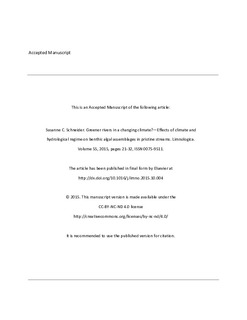Greener rivers in a changing climate?—Effects of climate and hydrological regime on benthic algal assemblages in pristine streams
Journal article, Peer reviewed
Accepted version
Permanent lenke
http://hdl.handle.net/11250/2570997Utgivelsesdato
2015Metadata
Vis full innførselSamlinger
- Publikasjoner fra Cristin - NIVA [2149]
- Scientific publications [1172]
Sammendrag
Excessive biomass development of benthic algae is often considered undesirable, but understanding the causes is confounded by complex interactions among driving factors. Pristine rivers allow a benchmark where human interference should be limited to climate change. In this study a time series comprising >20 years of annual benthic algae surveys from two pristine, soft water, boreal stream sites is used to determine whether year-to-year variations in benthic algal assemblages and cover were related to climate (temperature, precipitation, North Atlantic Oscillation) or hydrological regime. Total benthic algal cover ranged from 6 to 100% at Atna (the outflow of the Atna River from Lake Atnasjø), and from 3 to 50% at the headwater stream Li. Climate and hydrological regime explained 18 - 74% of the variability in benthic algal assemblages and cover. Generally, more variance was explained at Li than at Atna, possibly because (i) aquatic bryophytes blurred nutrient-mediated effects of climate and hydrology at Atna, and (ii) the upstream lake buffered hydrological variation. Temperature was more important for explaining benthic algal assemblages and cover at Atna, while hydrology was more important at Li. Climate and hydrological regime had no major impact on benthic algal taxon richness. High temperatures were associated with high benthic algal cover, particularly at Atna, while high suspended particle concentrations were associated with reduced benthic algal cover at Li, possibly due to scouring. Cover of the cyanobacterium Phormidium sp. increased at Li with increasing temperature, and decreased with prolonged periods of high discharge. Current predictions of climate change would lead to a “greener” Atna (increased cover of benthic algae), while Li would become more “bluegreen” (more Phormidium sp. but less filamentous green algae). It would also lead to a slightly more “eutrophic” algal assemblage at Atna (as indicated by the PIT-index for ecological status assessment), while a possible drift of the PIT-index is less clear at Li. The differences between Atna and Li likely reflect differences among river types, and it seems possible to make some generalizations: climate will likely affect benthic algae in lake outlets primarily via temperature, while headwater streams will primarily be affected via altered hydrology and particle concentrations.

